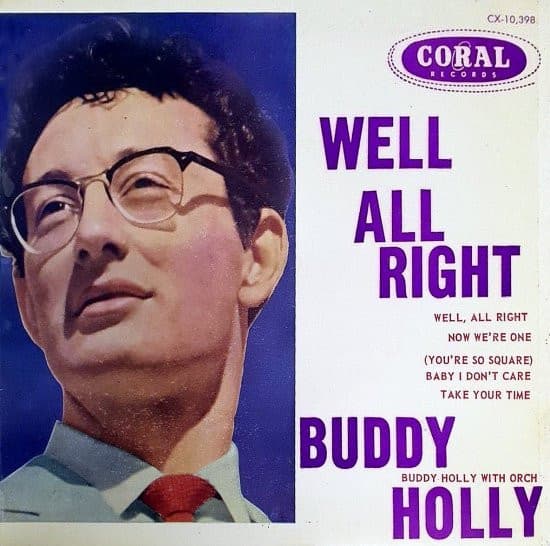
That Quiet Defiance: How Buddy Holly‘s Acoustic Masterpiece Challenged Rock ‘n’ Roll’s Noise
A remarkably mature and tender acoustic love song, defying a skeptical world.
There are records that simply hit the charts, and then there are records that quietly change the landscape of music forever. Buddy Holly’s “Well… All Right” belongs firmly in the latter category. While it might not have been a scorching chart-topper in the way some of his more raucous hits were, its story and substance make it one of the most significant moments in his tragically brief career. The original version was released in the US in October 1958 on the Coral label as the B-side to the single “Heartbeat” (Coral 9-62051). While the A-side scraped a minor chart entry, reaching as high as No. 82 on the Billboard Hot 100, “Well… All Right” itself did not register a major chart position in America upon its initial single release, often relegated to the shadows of the bigger hits. However, it later became widely celebrated through its inclusion on the posthumous 1960 album, The Buddy Holly Story, Vol. 2, and subsequent cover versions. This delayed recognition only underscores its status as an overlooked gem, a work of art so ahead of its time it took the world years to catch up.
The Song’s Intimate Story and Profound Meaning
The essence of “Well… All Right” is its stunning maturity and confident defiance, especially remarkable considering Holly was only 21 when it was recorded. Unlike the hard-charging rockabilly that made his name, this track strips everything back. It’s a beautifully simple performance built around Holly’s intimate vocal and the delicate rhythm of an acoustic guitar and soft hi-hat cymbal. This stark instrumentation gives the song an almost folk-like fragility and melancholy that was practically unheard of in the 1958 pop music scene, a time dominated by loud, electrified exuberance. It hints at Holly’s country influences but molds them into something entirely new—a precursor to the acoustic-driven sophistication that bands like The Beatles would later explore in albums like Rubber Soul.
The lyrics address the societal skepticism surrounding young love, confronting critics and doubters with a quiet resolve:
“Well all right, so I’m being foolish. Well all right let people know. That those foolish kids can’t be ready. For the love that comes their way.”
It’s a declaration of independence for a committed couple, a gentle but firm rejection of the older generation’s judgment. The song’s meaning is universal: the defiant joy of finding “lifetime love” and the courage to live that truth despite what “people say.” It’s an incredibly wise sentiment for a young man, delivered with an earnestness that makes the lyrics ring true even decades later. This wasn’t just another rock and roll tune; it was a deeply personal statement, showing the immense emotional depth Buddy Holly possessed as a writer.
A Legacy of Influence: From Clovis to Clapton
The recording session itself is often cited as a moment of pure inspiration. Written and recorded in 1958, the song’s collaborative songwriting credits include Buddy Holly, producer Norman Petty, and The Crickets members Jerry Allison and Joe B. Mauldin. It’s a testament to the creative synergy of the group at the Norman Petty Recording Studio in Clovis, New Mexico.
While many of Holly’s early hits are rightly celebrated, it’s this quiet side of his genius that proved most influential to the next generation of musicians. The acoustic texture and layered harmonies found in “Well… All Right” left an indelible mark on the burgeoning British Invasion sound. Think about the way early Beatles songs balanced rock energy with a folk sensibility—the blueprint is right here. Decades later, its timeless quality was proven again when the rock supergroup Blind Faith, featuring Eric Clapton and Steve Winwood, chose to cover it in 1969, giving the song a new, heavy psychedelic-rock interpretation and introducing it to a whole new audience. Later still, Santana took their turn in 1978. These covers are powerful proof of the song’s incredible, adaptable structure and emotional core, cementing Buddy Holly’s place not just as a rock and roll pioneer, but as a foundational figure for all of popular music. It’s a track that reminds us that sometimes, the most revolutionary sounds are the ones delivered with the quietest conviction.